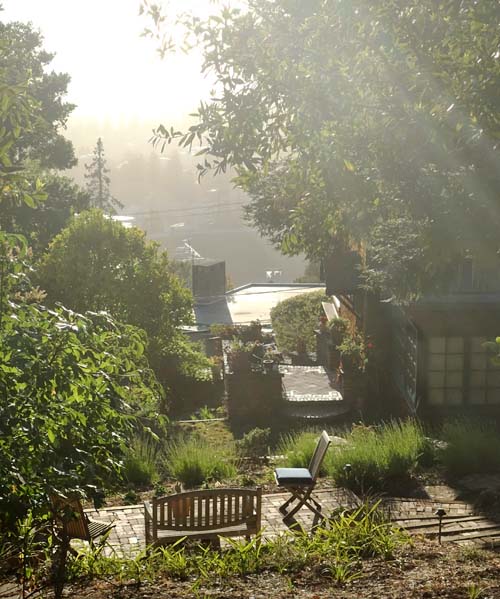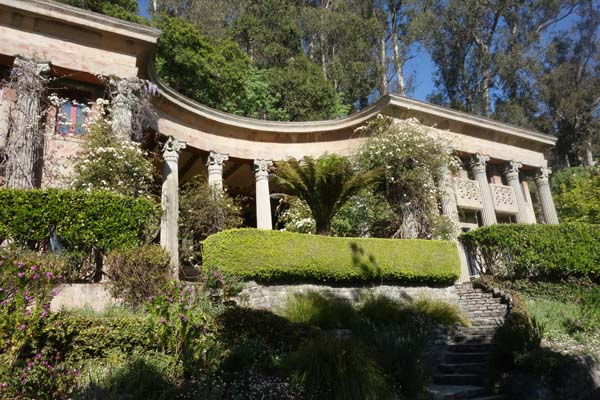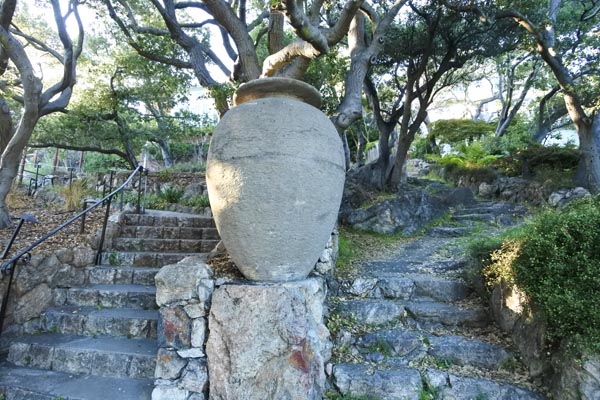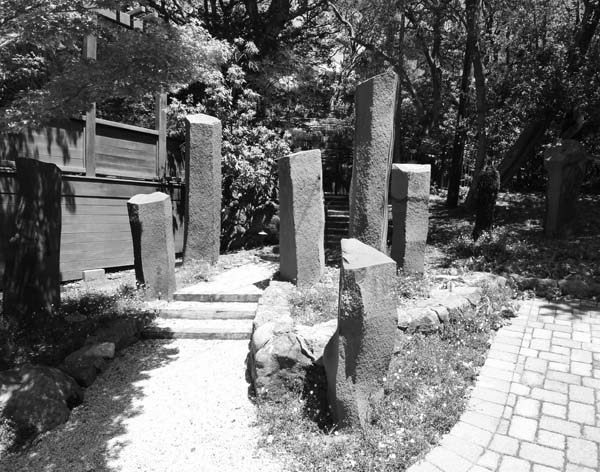Interviewsand Articles
What Do Gardens Mean?
by Richard Whittaker, Jul 25, 2021

From works & conversations #3 – The Garden As Art
- photos, r. whittaker
Can the garden be used as a fine art medium? My own encounter with the question was accidental. It happened only because, just before tossing another piece of junk mail into a recycling bin, I noticed the words “University of Chicago Press” and hesitated. On closer inspection, I saw it was a list of publications and, in thumbing through it, I found one title so appealing – What Do Gardens Mean? by Stephanie Ross – that I ordered it.
Looking back now from well on the other side of having gotten the book, and having read the whole thing, I can see that the most interesting moment took place right there - when I read the book’s title. It sparked a glimpse of something too promising to miss. And now, having spent a fair amount of time struggling with the question of the garden as art, my attention is drawn back to that moment. What was it that beckoned from that phrase? The very thought that there was a meaning to gardens pointed into depths beyond my ability to see. But somebody had seen – Stephanie Ross. Surely a journey of beauty and rare magic lay ahead.
There’s something intriguing about how such moments are so easily passed by. One is never ready for them, caught as one is in the midst of daily affairs. It’s only when such a moment crosses a certain threshold that one stops and listens to it. In this case, after ordering the book, I’d gone about my business. Still, something from that moment remained – the meaning of gardens. Meaning and gardens. Gardens of meaning. Is not the garden the most beguiling of our dreams?
To be honest, the question framed as, “Can the garden be a medium for fine arts?” immediately struck me as an artifact of the ivory tower. In terms of the living relationships of people without such pretensions to their gardens, it seemed rather far from the kitchen, as it were. And even though the book itself was a disappointment – competent as it might be in terms of its premise – the question it posed has been fruitful. It’s given me an excuse to explore many wonderful gardens, meet people fired with enthusiasm born of the horticultural life, and visit some garden memories of my own. However, in terms of the question as posed, I find myself unsuited to the task.
This much is clear: people calling themselves artists – and who are called artists by others – are making gardens and calling it art, or are making art in which the making of gardens is part of what they are calling art. And for a very long time, people who may not call themselves anything, have been making gardens that other people call art. Further, it would be greatly surprising if all this were not to continue. And given this time of profound meddling with nature and the dreadful results we are experiencing, the garden might be, in all its forms, the place best suited for calling us back to our senses – a role of gardens long established and held dear, whether consciously or not.

Our uses of, and responses to, gardens are fundamental, and our connections are robust. They persist beyond the permutations of culture and the supercharged surfaces of contemporary life. As such, the garden remains a source of sanity and a place to turn for a certain kind of comfort and relief.
Martin Heidegger claimed that what can be learned is what we already know. This seems strange at first. One might think there was a problem in the translation from the German. How can we already know what we haven’t learned? The thought comes to me because just at that moment when the question, what do gardens mean? registered, what I experienced throws a little light on Heidegger’s claim. It wasn’t as if the answer was there. No simple answer is possible, I suppose. There are many ways of looking at “the meaning” of gardens. Nevertheless it was as if the space opened by the question was immediately filled with something both certain and buoying.
I’m reminded of my childhood rock collection – not specifically a garden, and yet, with all my rocks carefully set out, not so unlike a garden: pieces of rose quartz, fool’s gold (pyrite), geodes, polished obsidian, lapis lazuli and countless others; these marvelous chunks of plain and polished mineral filled me with joy. My collection expanded slowly, mostly thanks to stops at roadside attractions on family trips. It never occurred to me to become a junior rock hound or even to go to the library to look at picture books. Nevertheless, when circumstance delivered me before a tray of mineral specimens or rough lapidary I was mesmerized by an attraction so basic it will have to go unnamed.
Although my rock collection disappeared many years ago, today the simple encounter with a suitable rock ordinaire hefted in the hand for a few moments of communion can, at certain unpredictable moments, uncover a vein of deep feeling that must be universal for our species. And although I’ve tried from time to time to capture some of this feeling in words, I have to leave it as simply being the satisfaction of rocks. For me, a good example close at hand is a rectangular chunk of red-toned granite. It’s polished on one side, broken at one end and weighs perhaps twenty-five pounds. I picked it up for a few dollars, a discard, from a maker of headstones. It’s simply a thing of beauty and if the nature of this satisfaction has to be classified, I’d say it’s ontological. It belongs to the realm of being.
From the front yard of my great aunt Rebecca and Uncle Charlie’s house, the hydrangea blossoms, like snowballs, remain in memory – and there was a grand backyard garden, too, where I often played. There were roses in abundance, petunias, peonies, irises aplenty, lilies of the valley, morning glory, honeysuckle and at the back fence, a line of hollyhocks with their upper blossoms too high for a three-year-old to reach.
The fragrance of the roses and a particular feature of the hollyhock blossom, are indelible memories. I could not have been the only small boy to notice they’re quintessentially designed for the capture of the jumbo, yellow and black stripe bumblebees that were often busy visiting the blossoms of that garden. It was to the stalking of these impressive bees that I trace my first memories of desire and a sense danger, having paid for my lust with a sting or two.
For the childhood eye, the particulars of nature, close up, are so vivid and alive, are they ever really forgotten? It’s easy to recall the close inspection of a tomato plant and its unforgettable, pungent odor; an ear of corn with its silk; a fat tomato grub; petunia blossoms so readily available to the toddler’s eye, or a yellow and black garden arachnid in its web – to say nothing of a butterfly or a snappy grasshopper that leaps suddenly into stripe-winged flight. My wife tells me her first conscious memory was of gazing into the bowl of a tulip blossom. It that moment she first became aware of herself.
But the childhood garden, for me, included a few experiences of loss as well. The story may sound trivial, unless you can recall your childhood perspective. It’s about a lizard I could not have imagined. I’d first spotted the unknown creature on a tree stump on the side of an Appalachian hill, part of which happened to be my family’s backyard. It was a big one, and I soon saw it was quick and had beautiful markings – particularly on the underside of its head and chest. Seeing it in all its glory, I was filled with a primitive desire to possess it.
The next day, I set out a galvanized bucket at the edge of the stump. It was a strategy bereft of the slightest sophistication. What were the chances a lizard would somehow blunder into an open bucket? But the following day, miracle of miracles, the lizard was inside the pail, unable to climb out. My heart stopped. What to do? In that moment, I acted in haste, taking the bucket and tipping it a little for a closer look. It was all the help the lizard needed and in a second, it was free. I can still recall that stark moment of loss.
Later on there was the discovery of hummingbirds - mesmerizing and utterly unobtainable - and later still, a nighttime visit of a luna moth that remained on our screen door long enough for a careful reading of its sublime beauty.
Of these recollections, and the feelings that remain to this day, it could be said, they are common, ordinary ones – not because they don’t stand out in sharp relief to the humdrum quality of daily life, but because something just like them must belong to everyone. Calling them garden moments seems apt. Not reserved only for an elite, they are privileged moments that have become part of our essential individual lives – pieces of knowledge – not of book learning, but from the tree of life.
At the time of this writing (in 2000), it was said that 70 million of us in the U. S. gardened. I’ve read or heard that it’s the country’s most popular pastime. Even though this is untrue on the face of it (what about watching television – or, today, attending to your cell phone?) it reveals something fundamental. This figure can err by the millions in one direction or another and still tell us the same thing. Whether gardening is called “pastime,” “work,” or “occupation,” it is among the things that are rooted close to the center of our lives. The garden is the place of meeting between nature and culture. In its deepest role, the garden is paradise. Here, each of us remains a child, cared for and free in an environment that is forever safe and nurturing. Against this background, there is a certain meaning in the idea of the fall, and an echo of the desire for return.

A garden can be the very glimpse of paradise or a showcase of power and personal pride. It can be the most minimal solution to filling the space between a building and the sidewalk – and much more could be said. The potential in all of this for art would seem to fit along the entire spectrum. As Piet Mondrian wrote, it might call us toward “a future, perhaps remote, in which there would be an end of art as something separated from our surroundings.” A.K. Coomaraswamy would remind us to look at traditional and indigenous cultures where no such divide has ever existed.
Linda Barry, in 1995, produced a brilliant comic strip episode. In just four panels of drawing and a few paragraphs of text, under the flag of counterculture hipness, she focused on the most ordinary of aspirations. “There is such a thing as a monster of happiness. It is one of our oldest monsters,” she wrote. In the strip, Barry referred to the forces aligned against the monster of happiness as the “monsters of misery.” “But the monster of happiness is quick and good at hiding,” she tells us. It hides in music and drawing and “in so many things that people create independently – which serve no purpose and get us nowhere.” The genius of casting the idea of happiness as a monster made it possible to consider this universal aspiration in a fresh way, free from cloying associations. It’s one of the things that real art can do.
But gardens need no such help. And it would be hard to argue that they serve no purpose. As for getting us nowhere, the garden’s deepest gift is in drawing us closer to where we already are. There’s a special joy in that return.

About the Author
Richard Whittaker is the founding editor of works & conversations and West Coast editor of Parabola magazine.
SUBSCRIBE NOW
TO OUR MONTHLY NEWSLETTER










Share Your Comments and Reflections on this Conversation:
On Aug 6, 2021 Barbara Schwartzbach wrote:
Gardening is believing in tomorrow 🌸On Aug 6, 2021 Sylvia Mosier wrote:
Gardens are God's gifts to us and all all animals and insects. Especially in the spring to watch the new growths rising out of the earth and the trees coming alive with their leaves. Gardens are a fresh breath of air and they give us hope, and peace and tranquility.On Aug 6, 2021 Jane Baker wrote:
I just picked up a rock yesterday to secure a note on the front step of a porch. This writing reminded me how much I enjoyed choosing that stone from a simple path and holding it for a moment. Why did that rock call and seem so perfect for such a simple task. It was once again remembering the known. Thank you Richard. Now I will not forget that rock and the experience.On Aug 6, 2021 Ramesh Shah wrote:
Garden brings peace & tranquility; a place to meditate; a place to feel loved.On Aug 6, 2021 nisha wrote:
Garden is where nature meets culture..going to remember that for a looooong time. Thank you Richard :)On Aug 5, 2021 Linda Flanagan wrote:
I love the synchronicity I experienced reading this after writing just that : my garden is living art! After 12 years in northern Minnesota ive come to enjoy the transformation of my husbands green lawn to a “Macy’s Day parade†Apple trees, hollyhocks galore, lady’s mantle, mint, bee balm, dill, Canadian anemone, globe thistle, onion chives, coneflower (32 heads this summer!), and my first raised bed with basil, tomatoes, broccoli and zucchini! I grew up on a vineyard in the Napa Valley and have always felt that vineyard and orchard are always resting inside my heart wherever I go. I’m grateful for clean water, fresh air, and compost that makes the garden glow. And let’s not forget the joys of bumblebees and hummers! Thank you Richard!On Aug 5, 2021 Helen C. Gennari wrote:
Richard, thank you for sharing your view of that patch of earth we call garden and what experiencing garden created in you. I do see a garden as a work of art, a source of life, and a sacred place where transformation is the primary language.Your writing took me back to my grandmother's log cabin with no garden but a simple yard that flowed out into a pasture abundant with Queen Ann's Lace, daisies dancing in summer breeze, wild roses, dew berries, milkweed and butterflies galore. Even more plentiful was the red and white clover and plenty of bees. As a five year old, I never tired of exploring Grandma's wild garden (which she shared with Nature)and picking goldenrod for her table. There was a cow path that led down to the creek where the croaking of frogs provided the background for the caw of the crow and the call of the Blue Jay.
I left that wild bit of property years ago but I never really left Natures garden. I can close my eyes and magically be there with all its sounds and smells and calls to lean into the arms of Nature.
On Aug 5, 2021 Lynn M Miller wrote:
For me gardens are love made visible, constancy, the return of hope, and a form of remembering. I aim for my garden to be pleasing over all, but it is always changing.After the long winter I find hope when the flowers signal to me that spring is coming. I am beguiled and reassured by snowdrops, one of the earliest to emerge. The tulips and daffodils signal that spring is solidly on the way, even though we are struggling with the heavy, gray, marine overcast that is so thick it makes me doubt that the sun still exists. A Pacific Northwest winter and spring is the experience of living in a half light.
Garden memories are life long. I have relationships with so many flowers from my relative's gardens, and I never see those flowers without remembering the people and places. One grandmother loved the Peace rose, and moss rose. A great aunt, who was in a wheel chair and couldn't even get into the yard, lived in a family home where lily of the valley maintained itself aided by hose streams aimed from the back porch (which she could access). And there were those stalwart hollyhocks on the alley. A grandfather, who never gardened, had a patch of blazing orange oriental poppies around the burn barrel on the alley. It was so spectacular that people would steal clumps of it in the night. None of these were artful gardens, but somehow a flower on its own is enough.
The sweetest man I ever knew, Dick Wilkinson, was in charge of gardens for the Missoula, Montana city parks. We thought of him as a magician with flowers. To visit his home garden was a revelation. He was always experimenting with flowers we'd never seen before. As well as being exceptionally kind to everyone, he shared his love of flowers all over the city. I think he came the closest to creating art.
On Aug 5, 2021 Patrick Watters wrote:
Ah gardens, yes indeed art! And best of all they are interactive art—as all sorts of neighbors enjoy them; other humans, assorted animals and the plants and rocks themselves. All of us have an innate capacity to create such art, and each creation is a unique expression of our inmost being. I have sat in Richard’s art garden and enjoyed it as we chatted about life. Not far that garden in Oakland are many others, including my sister-in-law’s delightful backyard sanctuary. I have my own “rough and tumble†nature garden out back here at da Moose Lodge. I suspect most may not find attractive, but the animals love it.